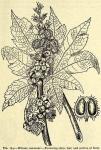 312. RICINUS.—CASTOR-OIL SEED. The seeds of Rici'nus commu'nis Linné (Palma Christi), a herbaceous plant about 4 to 6 feet in height, native to India, but cultivated in tropical and warm temperature countries; stems hollow, purplish-red; leaves large, palmately 9-divided, on long petioles, with glands at the apex of the petiole; flowers monoecious, in terminal panicles, the lower ones male, the upper female; male flowers-stamens numerous; female flowers-style 1, stigma 3, colored red; capsule covered with prickles, 3-celled, each cell containing one seed.
312. RICINUS.—CASTOR-OIL SEED. The seeds of Rici'nus commu'nis Linné (Palma Christi), a herbaceous plant about 4 to 6 feet in height, native to India, but cultivated in tropical and warm temperature countries; stems hollow, purplish-red; leaves large, palmately 9-divided, on long petioles, with glands at the apex of the petiole; flowers monoecious, in terminal panicles, the lower ones male, the upper female; male flowers-stamens numerous; female flowers-style 1, stigma 3, colored red; capsule covered with prickles, 3-celled, each cell containing one seed.
The seeds are about the size of a bean, oval-oblong, flattened on one side; at one end is a yellowish caruncle from which runs an obscure, longitudinal ridge (raphé) to the opposite end; externally smooth, of a glossy grayish color, mottled with reddish-brown from the removal, in places, of the thin, white pellicle investing the black, brittle testa. Embryo and albumen very oily; cotyledons broad and veined. Inodorous; taste sweetish, then acrid. They contain a fixed oil, 45 to 50 per cent, (Oleum Ricini), and a poisonous principle, ricin, which is left behind in the extraction of the oil, some cases of poisoning have occurred from the ingestion of the whole seeds, symptoms are violent gastroenteritis and collapse. They are more active, weight for weight, than the oil.
312a. OLEUM RICINI.—CASTOR OIL. The commercial fixed oil is extracted in several ways, the finest product being yielded by the process known as cold expression. It is a thick, viscid, transparent liquid with a feeble odor, and a mild, somewhat acrid and nauseous taste, soluble in its own weight of strong alcohol. On standing, it becomes thicker, and deposits a white, crystalline substance. Ricinolein (the glyceride of ricinoleic acid) constitutes the bulk of castor oil, with small quantities of palmitin, stearin, myristin and an acrid principle. A mild and efficient cathartic. Dose: 1/4 to 2 fl. oz. (8 to 60 mils). Formerly employed in making flexible collodion, 3 per cent.
ADMINISTRATION.—Various methods of administration to hide the nauseating taste have been devised. The three-layer method in which the oil is suspended between two layers of flavored watery or alcoholic liquid, is the favorite. For this purpose compound tincture of cardamon, spirit of peppermint, whisky, orange juice, lemon juice, lemonade or beer may be used. "The layers should not be stirred together." The favorite drug store method is to place some syrup of sarsaparilla in a glass and cause it to foam by adding carbonated water from the soda fountain or by a little tartaric acid and sodium carbonate. Then the oil is poured in without allowing any to get on the edge of the tumbler. "The mixture must not be stirred." The oil floats between some of the syrup below and foam above, and the whole is drunk without stopping. The oil is not tasted at all. The principle of these methods is to have the mouth and tongue moistened with a pleasant flavored liquid (the top layer), upon which the oil will readily slip down. For infants and children, an emulsion made with acacia and flavored syrup may be employed.—Bastedo.

